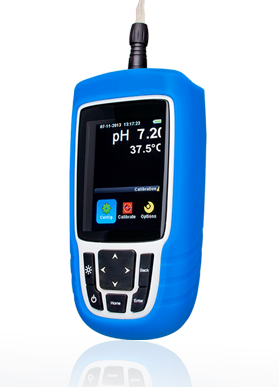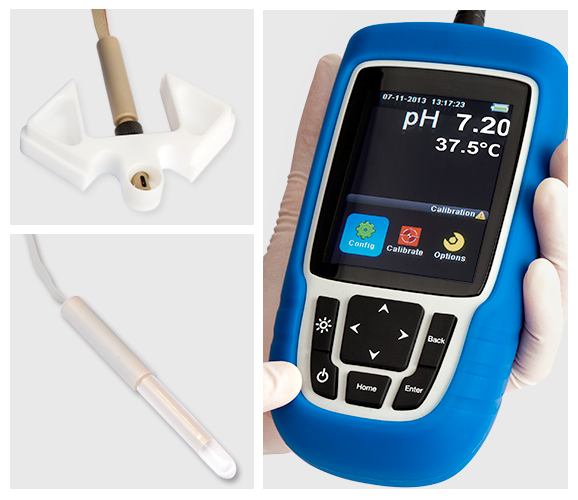pH Level Monitor
Building on the success and popularity of our pH Meter, RI now offer a more compact version. Smaller, lighter and with an improved probe, it allows you to measure media in real time from inside any popular incubator, including benchtop models.
The redesigned user interface guides you quickly through the calibration process.
With the pH Meter 3 you can see the pH of a media sample during culture to better inform lab protocols and optimise conditions.
This product is available for sale in the U.S.A and selected countries in Europe and the rest of the world.


Key Features
Accurate
New digital pH Meter readings with excellent calibration response and repeatability
Unique
IVF culture dish design and improved robust probe
Compatible
Suitable for use with all popular incubators including benchtop versions
Improved Usability
Increased data storage plus new LCD display and user interface
pH Meter 3
pH Level Monitor
The pH Meter 3 is suitable for various laboratory surveys and is compatible with standard media equilibration practices.
The amount of data storage has been increased to 2GB in anticipation of transfer to your PC for analysis by our dedicated software using adaptable graphs to display the pH and the temperature over time.
Details can also be archived, reported to other software programs and printed for lab records.
Why use the RI pH Meter?
Measuring the pH of culture media accurately is extremely difficult because the pH of media droplets under oil shifts above 7.4 within just 2 mins 30 seconds of removal from the incubator. So the likelihood is, if measuring the pH of media outside of the incubator, that you are measuring artefact pH levels.
The RI pH Meter provides accurate, real-time analysis of media pH in real time from inside any popular incubator, including benchtop models using its unique custom IVF pH probe. The probe fits into all incubators and allows embryologists to obtain the correct pH in the media.
No more guesswork or assumptions when trying to deliver the correct pH for the media being used.
The pH Meter is suitable for various laboratory surveys and is compatible with standard media equilibration practices.
How is it used?
A media droplet is made up in the pH probe well with an optional oil overlay and placed in the incubator. The thin ribbon cable can be passed out through a sample port or through the incubator door. The pH meter will then measure and display the pH in real-time.
The RI pH Meter probe imitates a culture dish so to take a reading, first calibrate the meter, and then place an aliquot of media into the pH probe well and place in the incubator to equilibrate. You can start the reading at the touch of a button.
The pH probe is robust and the PTFE probe holder is autoclavable. RI has worked with media manufacturers to verify the accuracy of the pH Meter for IVF. The RI pH Meter is accurate to ±0.01pH.
How does it work?
The probe has a semiconductor sensor at the tip. The probe is placed in the 4 well shaped holder. This holder has a well into which the media sample is placed. The probe also contains a sensor that measures the temperature of the sample and compensates the pH reading accordingly.
Software trend analysis
The meter has on board memory for datalogging. Test results stored by the pH meter can be easily downloaded to a personal computer for analysis and printing. With the auto archiving feature, the software is very easy to use.
| Part Number | Part Description |
|---|---|
| 7-90-101-3 | pH Meter version 3.0 with custom probe and Datalogging system |
| 7-90-103-3 | Probe extension lead for pH Meter (v3.0) – 2m |
| 7-90-104-3 | Replacement probe (v3.0) for pH Meter. Does not include Probe Holder |
| 7-90-107-3 | Replacement probe for pH Meter, version 3 |
| 7-90-107 | Replacement probe for pH Meter, versions 1 & 2 |
| 7-90-108-3 | Upgrade of previous pH Meter to v3.0 datalogging unit with new probe and holder |
| 7-90-120 | RI calibration/maintenance pack – 1x 50ml bottle of KCL, H2O, buffer 4.0, 7.0 and 10.0 |
| 7-90-118 | Probe maintenance pack – 1x 50ml bottle of KCL, H2O, buffer 4.0 |
| 7-90-111 | RI buffer solution, pH 10.0 – 50ml per bottle, pack of 10 bottles |
| 7-90-113 | RI buffer solution, pH 7.0 – 50ml per bottle, pack of 10 bottles |
| 7-90-115 | RI buffer solution, pH 4.0 – 50ml per bottle, pack of 10 bottles |
| 7-90-117 | Potassium Chloride (KCL) – 50ml per bottle, pack of 10 bottles |
Q: How much media should I place in the probe?
A: 0.5 to 1ml of media is required.
Q: Is there a special way to prepare media in the probe?
A: No, prepare the media drop the same way as your other dishes. You must ensure the media covers the sensor at the tip of the probe.
Q: When should I place the probe in the incubator?
A: You should place the probe in the incubator with your dishes, at the same time.
Q: How long is the warranty period?
A: Both the pH Meter main unit and probe have 12 months’ warranty.
Q: How quickly does the probe equilibrate?
A: The probe responds quickly, typically less than two seconds. The probe holder is designed to be placed in the incubator and mimic the gas transfer between incubator and media. If it is put into the incubator at the same time as the culture dish it will give a live reading of pH in the culture dish.
Q: Can I use the pH meter to adjust CO2 in my incubator?
A: CO2 levels will influence pH, but the relationship between the two is not a simple one. pH is also influenced by temperature, pressure and medium chemistry1.
1Pool T, (2004). Optimizing pH in clinical embryology. Clinical Embryologist, 7(3), pp.1–17. Available at http://www.clinical-embryologist.com.
Q: How do I calibrate the unit?
A: Use the calibration buffers provided by RI. The full calibration procedure is described in the user manual.
Q: How often does the probe need calibration?
A: Check with pH7.00 buffer daily. If the reading is incorrect then perform a recalibration. Calibration should also be done each time the meter is switched off and back on, whenever a new probe is connected, or whenever the calibration reminder on the meter appears.
Q: How long does a probe last?
A: The probe is relatively robust and should last for at least a year with correct maintenance.
Q: How do I clean my probe?
A: Soak briefly in a lab detergent such as 7X and rinse with purified water. Use the soft bristled brush supplied to clean the probe and rinse again with purified water. Follow this with a soak in potassium chloride solution. See the User Manual for full instructions.
Q: How long can you continuously monitor media pH in an incubator with IVF media and protein, before you have to clean the probe?
A: We currently recommend a maximum recording length of 24 hours. The probes naturally exhibit a small upwards drift in pH. Within 24 hours this drift should be no more than 0.14pH, and will be automatically corrected by the built in Drift Compensation feature.
Q: Does protein affect how often the probe needs to be cleaned and the life of the probe?
A: Proteins tend to adhere to the probe surface, hence higher concentrations will require the unit to be cleaned more regularly.
Q: How can I measure the pH of several incubators in succession?
A: We don’t recommend you measure in succession because each measurement should take 24 hours, and if measurements are done too quickly the accuracy is compromised. We suggest, upon acquiring the pH Meter you measure each incubator in the lab, following the instructions in the manual. When you are satisfied all incubators are working with sufficient uniformity the pH Meter should only be employed when there is a change to the conditions. This means when there is a new batch of media or CO2 a reading can be taken from any of the incubators, and that reading should be representative of all other incubators.

